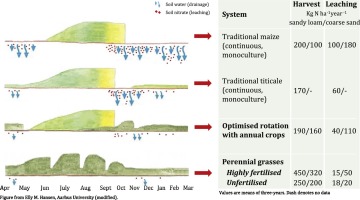Science of the Total Environment ( IF 9.8 ) Pub Date : 2018-03-28 , DOI: 10.1016/j.scitotenv.2018.03.155 Kiril Manevski , Poul E. Lærke , Jørgen E. Olesen , Uffe Jørgensen

|
Future biorefineries will prefer crops with high biomass yields, thus may precipitate fundamental changes to the agricultural landscape and the biomass production systems. Understanding the fate of nitrogen (N) in novel agricultural land uses is vital for product optimisation and environmental protection. This work reports and investigates the first multi-annual N balances for novel cropping systems optimised for high biomass production compared to traditional systems under North European climate and soil conditions.
In a three-year study, two types of novel systems, i) a rotation of annual crops optimised for maximum biomass production (maize, beet, hemp/oat, triticale as main crops, and winter rye and winter oilseed rape as “second” - cover crops), and ii) perennial grasses (intensively fertilised (festulolium, reed canary grass, tall fescue and cocksfoot), low-fertilised (miscanthus) and unfertilised (grass-legume mixtures)), were compared with iii) traditional systems (continuous maize or triticale, and a cereal crop rotation) at two sites in Denmark varying in temperature, rainfall and soil type (sandy loam and coarse sand). Harvested biomass N and soil nitrate dynamics, as well as model-supported nitrate leaching and field surface N balance (input minus output) of the systems were compared.
At each study site, the fertilised perennial grasses outperformed all other systems by doubling biomass N and reducing nitrate leaching by 70–80% compared to the traditional systems. Compared to continuous maize monoculture, the optimised rotation supplied 70% more biomass N and 40% less nitrate leaching on coarse sandy soil, whereas on sandy loam soil it yielded about 10% less biomass N with 50% less nitrate leaching. Field surface N balances were overall neutral/positive, except for festulolium and continuous maize monoculture that slightly mined the soil for N. When N losses by leaching, denitrification and volatilisation were included, soil total N stocks were estimated to decline for the majority of the systems at both sites.
中文翻译:

用于将原料生产到未来生物炼油厂的创新种植系统的氮平衡☆
未来的生物精炼厂将青睐具有高生物量产量的农作物,因此可能促使农业格局和生物量生产系统发生根本性变化。了解新型农业用地中氮的命运对于产品优化和环境保护至关重要。这项工作报告并调查了与北欧气候和土壤条件下的传统系统相比,为实现高生物量生产而优化的,针对高生物量生产而优化的新型种植系统的第一个多年期氮平衡。
在一项为期三年的研究中,采用了两种新型系统:i)轮作优化以实现最大生物量生产的年度作物(玉米,甜菜,大麻/燕麦,黑小麦为主要作物,黑麦和冬季油菜为“第二”) -覆盖作物),和II)多年生草(集中受精(festulolium,草芦,高羊茅和鸭茅),低受精(芒草)和未受精(草豆科混合物)),用比较三)在丹麦两个地点的传统系统(连续玉米或黑小麦,以及谷类作物轮作),温度,降雨量和土壤类型(砂壤土和粗沙)均不同。比较了收获的生物量氮和土壤硝态氮动力学,以及模型支持的硝态氮淋失和田间地表氮平衡(输入减去输出)。
在每个研究地点,与传统系统相比,施肥的多年生草优于其他系统,其生物量氮增加了一倍,硝酸盐淋失减少了70-80%。与连续玉米单作栽培相比,优化轮作在粗糙的沙质土壤上提供了70%的生物量氮和40%的硝酸盐淋溶,而在壤土壤土上,它的生物量氮减少了10%,而硝酸盐淋溶减少了50%。田间表面的氮平衡总体为中性/正值,除了通叶草和玉米连续单作会轻微挖掘土壤中的氮。当包括因淋滤,反硝化和挥发引起的氮损失时,估计大部分土壤氮的总存量将下降。两个站点上的系统。



























 京公网安备 11010802027423号
京公网安备 11010802027423号